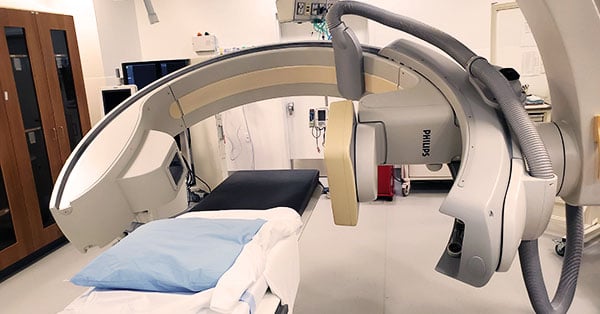
In the world of Cath Labs, there is a plethora of options to choose from. Single plane vs. bi-plane, varied detector sizes, special features, the list of possible configurations goes on and on.
Most folks are able to arrive at relatively quick decisions on many cath lab options, but we often see some confusion when it comes to choosing floor mounting or ceiling mounting. Both types require a facility to install a ceiling structure, so does it really matter how the lab is mounted? Absolutely!
Below, we'll break down the differences that might inform your choice of either a floor-mounted or ceiling-mounted cath lab system.
To compare, we'll use the GE Innova 3100 IQ (floor-mounted) and Philips Allura XPER FD20 (ceiling-mounted) as examples.
Cath Lab Ceiling Structure Loads
As we mentioned earlier, whether your Cath lab's gantry will be mounted on the floor or the ceiling, you will need to install some kind of support structure in the ceiling of your future Cath suite.
The difference is the amount of weight that the structure will need to bear.
Floor-Mounted Structure
In the case of most floor-mounted systems, including our example, the Innova 3100, the only equipment that will need to hang from the ceiling is the monitor boom, with surgical lights and a lead shield as options. All of these items combined weigh about 700 pounds.
Ceiling-Mounted Structure
Our ceiling-mounted example, the FD20, has a similar monitor/light/shield weight of around 764 pounds (give or take, depending on the options you choose for your specific system).
Unlike the Innova, however, the ceiling structure also needs to be able to support the FD20's 2,557-pound gantry, for a total of 3,321 pounds. Installing a structure that can bear this load will involve far more labor and heavier-duty materials than a structure for a 700-pound load.
For ceiling-mounted labs, installing heavy-duty ceiling structures will account for several thousand dollars of your installation quote.
Cath Suite Ceiling Height/ Floor Level
With a least a portion of the equipment hanging from the ceiling in either case, there are some recommendations about minimum ceiling heights.
Floor-Mounted Height Recommendations
Since the GE system is just the monitors and light/shield hanging, there is some flexibility. GE recommends 9’6” from finished floor to finished ceiling for the Innova's hanging components, but gives some leeway in offering a minimum height of 9’, and a maximum deflection of 1/16” when the rails of the structure are under load.
Ceiling-Mounted Height Recommendations
The FD 20 is a very different story. Because the gantry interacts with the table, there are very specific requirements that must be adhered to in the site planning process.
Philips requires a ceiling height of 9’6 3/16” with an allowance to be up to 3/8” higher, but not any lower.
The ceiling must also be square and level to within +/- 1/16” per 39”.
When working with the FD20, you also have to take into account the full movement of the gantry, and ensure the floor is level within the same tolerances as the ceiling – 1/16” for every 39”.
In contrast, the floor for the GE unit must be level 1/8” over 10’.
If you're installing a cath lab into an existing building, the choice of which mounting style to use may be influenced by your current ceilings and floors as well as your appetite for taking on possible remodeling costs.
The Takeaway
If your ceilings are already 9'6" and some change, you can't really go wrong with either a floor-mounted or ceiling-mounted system. Keep in mind, the type of cath lab you choose will ultimately ride on your current facility layouts, and budget.
Systems in both categories will serve your patients and your physicians well. If your ceilings are lower, you can save yourself some remodeling costs by choosing a floor-mounted system.
Whichever way you may be leaning, our team is ready to help. Contact our Cath lab experts today to talk through which option may be right for you.

Kenn Dextrom
Kenn Dextrom is the Director of Product Manager at Block Imaging. He aims to provide clear direction and careful planning for Interventional Cath Lab buyers and working with the Block Imaging product team to provide excellent solutions for our customers. Out of the office, he spends most of his time keeping up with his wife and their three energetic sons.





